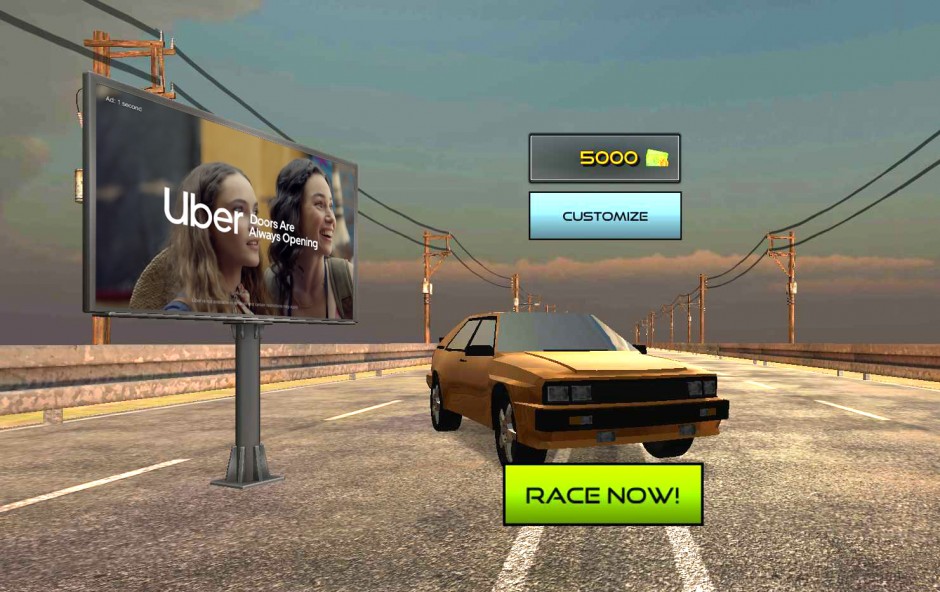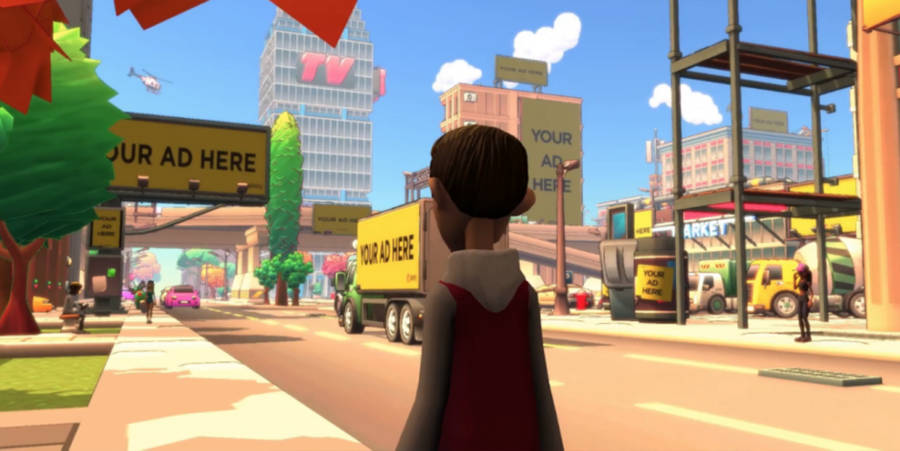Could in-game advertising one day rival Facebook’s scale? Ad pioneers, enabled by programmatic tech, believe targeted ads and branded integrations delivered natively into 3 billion gamers’ favorite worlds could bring about a new era of economic prosperity and fund the birth of a metaverse. As part of our deep dive into all things gaming, The Drum talks to the very execs laying these virtual foundations.
Mobile gamers are all-too-familiar with interruptions such as immersion-breaking ads flanking short sessions in freemium titles. Some opt to watch rewarded ads (view for lives), some stump up cash to block them, and others inevitably ditch the game for good. For better or worse, advertisers are now integrating ads into other gaming worlds.
For years, ad execs fantasized about placing real-world ads into fully-realized gaming worlds such as Grand Theft Auto. With programmatic buying platforms reaching maturity, now anything can be inventory, be it an in-game billboard, a bus stop, a bin shed, a mural, a generic shopfront or even a power-up. They may resemble billboard ads – albeit sometimes wrapped up in cartoonish visuals – but they are bought digitally and can be targeted on a one-to-one basis, Minority Report-style, unlike real out-of-home (OOH).
This inventory, sometimes called virtual OOH or out-of-world, is still young, but top brands are using these opportunities to be placed in gaming worlds and top ad networks are assembling teams capable of buying the media.
So, let’s meet the people laying the groundwork.
The long-term vision
In the past few years, Admix has received $10m in funding to do just that. Samuel Huber, the in-play ad platform’s founder and chief executive, says: “It’s a big opportunity. There are billions of people gaming every day who most brands are completely neglecting. That’s almost another Facebook.”
Gaming is a few levels away from being a comparative media channel, Huber admits. But there’s a lot of motivation to drive it. He laments the current “terrible user experience” of interruptive ads in mobile gaming: “It was a necessary evil.” But now, with a team of 50, he’s building a full-stack to connect publisher inventory with advertiser demand, has adopted IAB formats and is measuring impact through Integral Ad Science. It’s shy of the finished product, but some 300 brands currently trust it.
Available to them are in-game banners and videos. Huber likens these to gateway ads – they’re what marketers are used to buying, but they’re not realizing in-game’s potential. “It’s just a way to get the brands to start understanding gaming, but it isn’t really our long-term vision – every media channel eventually develops formats that are native to the channel
.So, his vision? Imagine a footwear brand’s gaming team programmatically buying footwear power-ups across a stable of sports games. The branded asset gets applied to the player character and shows a product benefit by giving them a power boost. On a cool character, this is virtual influencer marketing. The shoes may even be seamlessly shoppable too, adding a performance element to the campaign. Further complicating the media buy, imagine this is a popular esports title then broadcast to thousands of viewers – there’s added value on these buys, what the world of TV may call ‘waste’.
And as the space is maturing, brand safety discussions could soon determine the profitability of select genres. That shoe company may not want to fuel murderous sprees in Grand Theft Auto, or have its billboard serve as a backdrop to one.
Huber says violent shooters are already seeing lower CPMs on the marketplace. To avoid this, he imagines video game scenes could be ranked for brand safety rather than pegging a whole title as mature and depriving it of that demand – especially in mobile where sessions are short and proximity to violence less likely as a result.
These conversations are still young. As are Huber’s ambitions. Gaming’s not the end game as he builds “a business model for 3D worlds” and the metaverse. There’s virtual reality, training, manufacturing and education purposes implications for its 3D ad products too.
Cheat codes
Alex Ginn, director of sales at Adverty, talks of creating a “seamless world between brands and people”, but talks up the need for data that would do for ad effectiveness what cheat codes do for the players.
Adverty offers in-menu and in-play ads – both self-explanatory – but Ginn talks up the need for a strong bedrock of data and insight. If the ad placement is not relevant, surely it is still interruptive?
He says: “Contextual sensitivity is critical for in-game ads and this is a big problem within digital advertising. It’s important to focus on experiences rather than simply trying to shift products, to think of your brand, what it stands for and what it can offer. Interruptive ads spark backlash wherever they are placed. The aim, as with all advertising, is to feel natural and to provide a non-obtrusive experience that is entertaining or informative – or both.”
Adverty’s research (conducted with Dentsu) found that in-game ads offered a 31% more positive user experience compared to web display advertising. There were various more benefits with well-delivered ads. A YouGov study from The Drum found a fifth of people had bought a product they saw in a gaming ad. And many were happy to view ads to access games for free.

Ginn cites a 2020 campaign working with media agency the7star to promote a new Twenty One Pilots album. OOH-style creative was distributed on FPS Critical Ops to target young male rockers. Ginn says: “Using our AI technology, we only billed impressions guaranteed to have been viewed entirely, removing all risk from the campaign.”
While possibilities exist throughout gaming, he believes mobile is where the real action is. “Programmatic represents the only path forward into a sustainable in-game ad business. Mobile is mainstream and represents a land-grab opportunity for brands”.
Gameception
So is there a sleeping Facebook waiting to be awakened in gaming? Can these separate games scale up? Well, that’s already happening to an extent.
Samuel Drozdov is chief executive and co-founder at Bloxbiz, an ad platform that lets developers deliver ads in hugely successful games network Roblox. An open gaming ecosystem with an estimated 202 million users, Roblox’s blocky kid-friendly stable of community-built games focus on “unstructured play”.
Drozdov was inspired to bring some of Fornite’s gaming integration magic into this untapped market. “I previously worked at Facebook designing analytic tools for advertisers, and as a gamer, at the intersection of all those interests, I was thinking about how to help brands create a presence in virtual worlds.”
Bloxbiz was founded to meet that need. Its in-game ads reach more than 15 million players every month across more than 50 games, bringing in brands via partnership with adtech platform Venatus.
Drozdov admits: “We’ve got really lucky on timing. Roblox and in-game advertising have reached a point where a company like Bloxbiz can be profitable.
“People are starting to understand that games are not just games anymore but social networks with immersive experiences – and then it’s a smaller leap to advertising in these spaces.”

For Roblox, built on a bedrock of creators, there are branded content opportunities. Perhaps a prominent designer could build a branded experience like KFC’s Animal Crossing island.
Maybe these experiences are more self-selective than targeted using wells of data, particularly with gaming being such a child-friendly medium. There are restrictions in what tracking and data collection can be implemented here.
Drozdov says: “We do not collect personal information about players, which is unique compared to the majority of other ad platforms out there.” In most scenarios, this would be pitched as a negative, but here he’s looking to drive effectiveness without these added difficulties to navigate.
More broadly in the market, “the in-game adtech stack is still not up to par with the traditional adtech stack, but brands should be early adopters and take advantage of the opportunities for a high share of voice before everyone is fighting to reach the same audience”.
Right now, Bloxbiz is running a campaign for DreamWork’s Spirit Untamed.

t’s clear that the approaches differ and some firms will be bigger winners than others. Gaming as a media platform is still being formed – some marketers will be happy to know they’re pushing a family film in Roblox, which is played by some 1.5 million kids in the UK, while others will demand dossiers of attribution reports from their partners.
Maybe together these titles won’t offer the scale of a Facebook, but it’s a clear opportunity to add value to the recreation of billions. Like tackling a tricky dungeon or harrowing boss rush, games marketers will need to adopt an inventory of tools and tactics to seize the day.
…
This article first appeared in www.thedrum.com
Seeking to build and grow your brand using the force of consumer insight, strategic foresight, creative disruption and technology prowess? Talk to us at +971 50 6254340 or mail: engage@groupisd.com or visit www.groupisd.com/story




